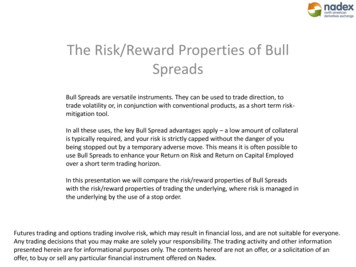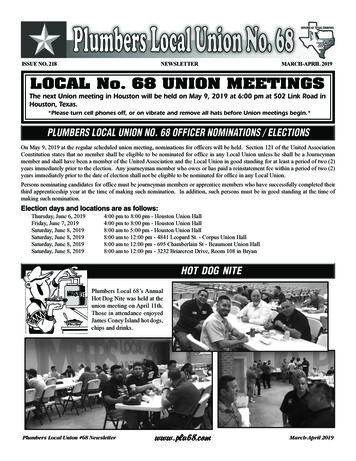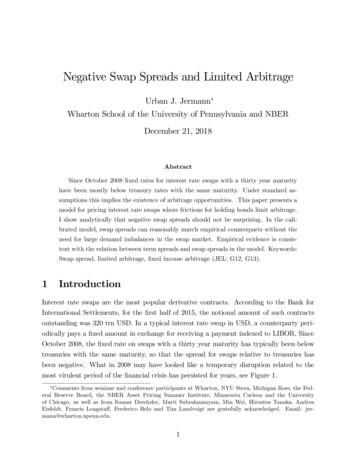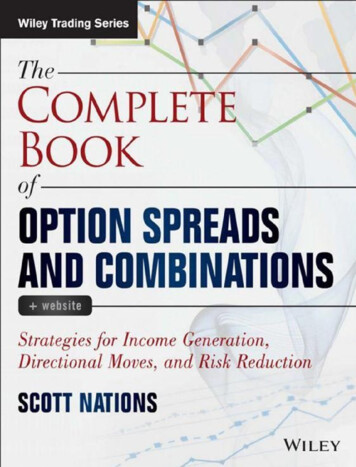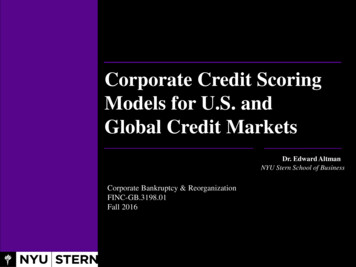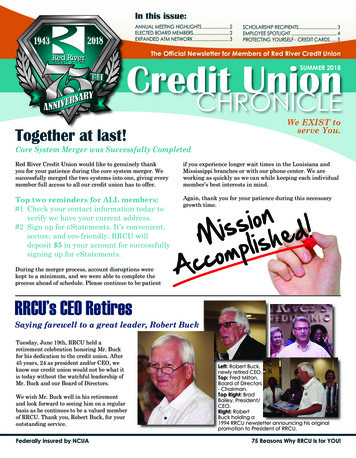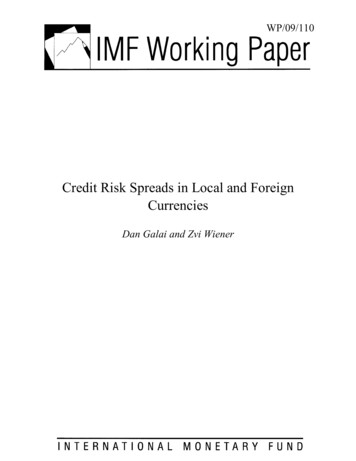
Transcription
WP/09/110Credit Risk Spreads in Local and ForeignCurrenciesDan Galai and Zvi Wiener
2009 International Monetary FundWP/09/110IMF Working PaperMonetary and Capital Markets DepartmentCredit Risk Spreads in Local and Foreign CurrenciesPrepared by Dan Galai and Zvi Wiener 1Authorized for distribution by Daniel C. HardyMay 2009AbstractThis Working Paper should not be reported as representing the views of the IMF.The views expressed in this Working Paper are those of the authors and do not necessarily represent thoseof the IMF or IMF policy. Working Papers describe research in progress by the author(s) and arepublished to elicit comments and to further debate.The paper shows how—in a Merton-type model with bankruptcy—the currency compositionof debt changes the risk profile of a company raising a given amount of financing, and thusaffects the cost of debt. Foreign currency borrowing is cheaper when the exchange rate ispositively correlated with the return on the company’s assets, even if the company is not anexporter. Prudential regulations should therefore differentiate among loans depending on theextent to which borrowers have “natural hedges” of their foreign currency exposures.JEL Classification Numbers: G12; G13; G15Keywords: credit spread, foreign debt, currency mismatch, Merton’s model, dollarizationAuthor’s E-Mail Address: dan@sigma-pcm.co.il1School of Business Administration, The Hebrew University of Jerusalem. We wish to thank Zvi Bodie, MichelCrouhy, Alain Ize, Rick Levich, Haim Keidar-Levy, Benzi Schreiber and Tony Saunders for their insights andespecially Daniel Hardy for his suggestions and fruitful discussions, as well as the participants of the seminarson Risk Management in Moscow and Almaty, NUS in Singapore, the Fifth World Congress of BachelierFinance Society and the IMF. We benefited from the great editorial assistance of June Dilevsky. Weacknowledge financial support from the Zagagi Center and the Krueger Center at the Hebrew University. Thiswork was completed while Galai was a Visiting Scholar at the IMF in August 2008.
2ContentsPageI. Introduction .3II. The Model .4III. Numerical Examples and Illustrations .7IV. Credit Spreads and Modigliani and Miller Propositions .9V. Implications and Conclusions .13References.18Tables1.The Euro-Denominated Debt Spread, Face Value, PD, and the Cost of Credit Risk asa Function of Correlations .82.Betas of Stocks and Foreign Currency Bonds for Various Correlations .11Figures1.Spreads on Foreign-Currency Bonds and Correlations .92.The Expected Return on Stock (yS) as a Function of the B/S Ratio .123.The Expected Return on Stock yS as a Function of the B/S Ratio and CorrelationCoefficient ρ .134.FE as a Function of F .155.FE as a Function of F .16AppendixesI.Determination of the Face Value of Debt in the Foreign Currency.15II.Firm Value, Exchange Rates, and Inflation .17
3I. INTRODUCTIONThe world today is characterized by growing globalization of enterprises, banks, andfinancial markets. Capital raising, once the province of local capital markets, is increasinglybecoming a global activity. In the past it was rare to see firms access pools of financingbeyond national boundaries. Today, companies operating internationally and dealing in manycurrencies have opportunities to finance capital investments and activities in diverseinternational markets The ability to raise capital abroad compels companies to examine theeconomic implications of such opportunities.Even when financing from abroad is not available, the practice of raising money locally, butdenominated in foreign currency is widespread. Especially in countries that have sufferedhigh inflation, dollarization can become pervasive (see for example Armas, Ize, and LevyYeyati, 2006; Chan-Lau and Santos, 2006; and Havrylyshyn and Beddies, 2003).2 Not onlydo people place their savings in foreign currency assets as a better store of value, manycompanies and households prefer to borrow in foreign currency. They are clearly willing toincur foreign exchange risk in exchange for a reduction in other elements of the cost offunding.In this paper we study the micro-level factors that should be considered by a borrower whenstructuring debt denominated in various currencies. The macroeconomic implications of loandollarization and foreign borrowing, the factors that contribute to the use of foreign currencyas a medium of exchange, and the determinants of saving in foreign currency are notaddressed.The issue of currency composition of debt for both corporations and sovereign governmentshas attracted the attention of academics and policy-makers. Two dominant approaches to thisissue can be found in financial literature. The first approach is to focus on “currencymismatch,” i.e., discrepancies between the direct currency composition of assets andliabilities held by corporations and sovereigns.3 Currency mismatch is often singled out as animportant factor of financial crises, particularly in developing economies (Caballero andKrishnamurthy, 2005; Catao and Sutton, 2002; Duffie, Pederson, and Singleton, 2003;Gibson and Sundaresan, 2001; Gray, Merton, and Bodie, 2007; Longstaff, Pan, Pedersen, andSingleton, 2007; and Weigel and Gemmill, 2006. Armas and others (op. cit.) contains manypapers on the causes and consequences of de facto dollarization in many South American2The phenomenon is not restricted to high-inflation countries. A significant portion of lending in Austria isdenominated in foreign currency.3Google search of “currency mismatch” shows about one million results.
4countries and elsewhere. Chan-Lau and Santos (2006) propose several structural models formeasuring default risk for firms suffering from currency mismatches in their balance sheets.The second approach to analyze the financial exposure stemming from the currencycomposition of debt is to focus on the hedging activities of firms and on the empiricalrelationship between the rate of return of a firm’s shares and exchange rate fluctuations. Ingeneral, exposure to foreign currency risk can be mitigated by pricing policy, by “operationalhedges,” such as locating plants and suppliers in the foreign markets, and, by financialactivities, including the determination of debt composition and use of financial derivatives.While some empirical studies estimate that the correlation between share prices andexchange rates is insignificant (e.g., Domingues and Tesar, 2006; Griffin and Stulz, 2001;and Jorion, 1990), theoretical models predict that foreign currency exposure for manycorporations should be substantially larger than (see for example Bodnar, Dumas, andMaston, 2002).The specific problem we address in this paper is whether the currency composition of debtmatters. How should the choice of currency in bond offerings affect the credit spread for agiven firm? Credit spread is defined as the yield to maturity of the bond, minus the defaultfree rate, in the relevant currency. One may have an intuition that, since the resultingfinancial structure when companies issue debt in local or foreign currency remains the same,the risk premium should be equal and the currency composition is irrelevant. However, weshow that currency composition matters to the extent that it engenders or mitigates a firm’sfinancial risk, and it should therefore be reflected in differential credit spreads for a givenlevel of debt.Hedging activity by multinational firms and the rationale behind it is discussed at length inthe financial literature. Generally speaking, firms hedge currency exposure to mitigate risksinherent in mismatched revenues and expenses. The literature plays less attention to the otherside of the coin, i.e., how financial decisions can be affected by the nature of corporate’s“real” assets. Specifically, we incorporate the relationship between the statistical distributionof corporate assets’ rate of return and the probability distribution of the currency of the debt.We show how the level of debt which minimizes the probability of default (POD) (andtherefore the costs of borrowing) can be determined as a function of the uncertainty of afirm’s investments and the correlation between this uncertainty and exchange rateuncertainty.II. THE MODELWe analyze differential credit spreads arising from the choice of raising debt financing inlocal or foreign currency, by using the economic model proposed by Merton (1974). AnAmerican firm, with asset value V, floats pure discount debt with face value F, and market
5value B, to be redeemed at time T, where the risk-free rate is a constant r. All the aboveparameters are in dollar terms.It can be shown that, under the set of assumptions required for the Black-Scholes (1973) andMerton (1974) models to hold, that the yield to maturity for such a loan, y, is given byy 1 B 1 V ln r ln rT N ( d1 ) N (d 2 ) T F T Fe (1)where σ T 2 , d d σ T ,21σ T Vln rTFed1 2σ is the standard deviation of the rate of return on the firm’s assets, and N( ) is the cumulativestandard normal probability function. The spread between the yield to maturity of the localcurrency bond and the safe local interest rate iss y r 1 V ln r T N ( d1 ) N (d 2 ) T Fe (2)Following the standard Merton model, we can express the value of the bond asB Fe rT Put ( strike F ) Fe rT V N ( d1 ) Fe rT N ( d 2 )(3)where Fe-rT is the present value of a pure discount default-free bond maturing at T with facevalue of F, and Put (strike F) is the present value of the credit risk of the pure discountcorporate bond, promising to pay F at time T, with current assets valued at V. Aftersimplification, we haveB V N ( d1 ) Fe rT N (d 2 )(3’)Now assume that the same firm is considering issuing bonds representing the same presentvalue of debt but denominated in euros, i.e., x0 BE B where subscript E denotes the eurocurrency, and x0 is the current exchange rate (assumed for simplicity’s sake to be 1:1 ). Wefurther assume that the time to maturity, T, is unchanged, and the risk-free Euro-denominated
6interest rate is rE. Since we introduce another stochastic variable beyond V, namely, theexchange rate x between the dollar and the euro, we have to add an assumption that theexchange rate also follows a Wiener process with a constant σx, which represents thestandard deviation of the rate of exchange rate fluctuation, and a constant correlation, ρ, withthe rate of return on the firm’s assets. Let σE denote the volatility of the firm’s assets in euroterms, and VE V/x0. By the definition of the correlation ρ one can easily show thatσ E2 σ 2 σ X2 2σσ X ρ .(4)We must simultaneously find the appropriate face value of the euro-denominated bond, FE,and the yield to maturity of the bond, yE, such that x0 BE B. In order to find the face valueof the foreign currency denominated debt, FE, such that the current value of the debt in dollarterms is equal to B, we need to solve the following equation:()B V N ( d1 ) Fe rT N (d 2 ) x0 VE N ( d1E ) FE e rET N (d 2 E ) x0 BE(5)The left hand side of (5) is from (3’), and the right hand side is the equivalent expression fora foreign-currency bond, andd1E VEln FE e rET σE σ E2T 2 , d d σ T .E2E1ETFE is the sole unknown in equation (5), and the right hand side of the equation is monotonicin this variable. Hence, a unique solution always exists.The spread for a debt denominated in foreign currency is given bys E y E rE 1 VE ln N(d)N(d) 1E2E T FE e rET (6)The question is whether credit risk spreads s and sE are necessarily equal or is one larger thanthe other under certain conditions. This issue cannot be resolved analytically since derivingFE from equation (3) can be accomplished only by a numerical solution; an analytic solutioncannot be found because d1E and d2E are functions of FE).
7III. NUMERICAL EXAMPLES AND ILLUSTRATIONSLet us illustrate this approach with numerical examples. Assume that an American companywith asset value of V 100, issuing a pure discount (zero coupon) bond in U.S. dollars with acurrent value of B 70, maturing in T 5 years. The standard deviation of the assets’ rate ofreturn (in dollars) is σ 20 percent. We further assume that the risk less interest rate in the USis r 5 percent. Given these parameters, it can be shown using (3’) that the face value of thebond must be F 98.27 in order to obtain a current value of 70. From equation (2) for thebond spread, it can be shown that the yield to maturity on the bond is y 6.78 percent, or aspread of s 178bp. The risk-neutral probability of default (RNP) as measured by N(-d2) is35.4 percent. We can also calculate the present value of the credit risk of the bond (seeCrouhy, Galai, and Mark, 1999), by the value of the 5-ye
Keywords: credit spread, foreign debt, currency mismatch, Merton’s model, dollarization . exchange rate x between the dollar and the euro, we have to add an assumption that the exchange rate also follows a Wiener process with a constant σx, which represents the standard deviation of the rate of exchange rate fluctuation, and a constant correlation, ρ, with the rate of return on the firm .
